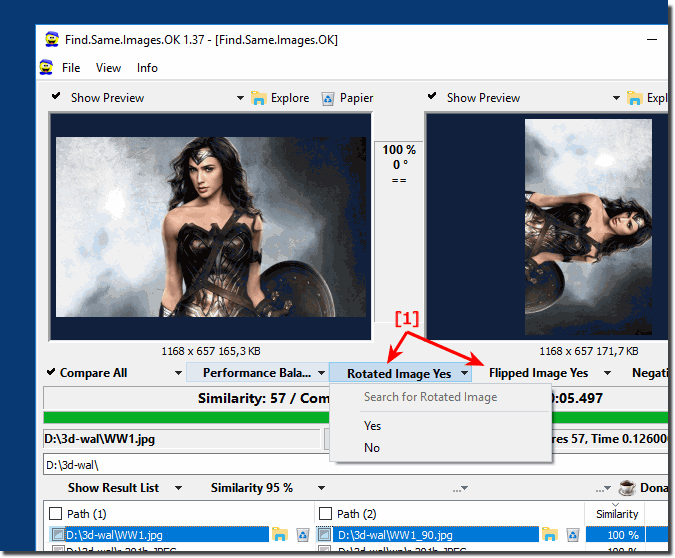Sometimes if you make an image on you smartphone or iPhone and save it on PC and then flip or rotate the image you can find the original again.Rotated or even mirrored images can be found using Find.Same.Images.OK. Even if the images have been changed in size or dimension. However, these image search options are disabled by default because they take additional time.
Contents: 1.) ... Search for mirrored and rotated images!
|
| (Image-1) For what the flipped and rotated image search? |
 |
Info:
Apples MAC OS Applications are spoiled in the general with various graphics programs, however, the mirrored and rotated image search is not magic. No, there are just a couple of algorithms that do your job, much like the mighty Google and Bing search as you can see above in Windows 10 shot screenshot, it really makes very good sense to use this image search feature No matter if it's a native Windows desktop PC, on the Tablet PC or MS Surface Pro and Go, or even on a Professional MS Server operating system, earlier / older versions of Microsoft's Windows operating systems are suitable.
Searching for mirrored or rotated images is like discovering a hidden garden full of fascinating flowers that bloom in a variety of colors and shapes. Each picture is a flower that tells its own story, but sometimes we want to see how these flowers change when they turn in the wind or when they are looked at in the mirror.
Apples MAC OS Applications are spoiled in the general with various graphics programs, however, the mirrored and rotated image search is not magic. No, there are just a couple of algorithms that do your job, much like the mighty Google and Bing search as you can see above in Windows 10 shot screenshot, it really makes very good sense to use this image search feature No matter if it's a native Windows desktop PC, on the Tablet PC or MS Surface Pro and Go, or even on a Professional MS Server operating system, earlier / older versions of Microsoft's Windows operating systems are suitable.
Searching for mirrored or rotated images is like discovering a hidden garden full of fascinating flowers that bloom in a variety of colors and shapes. Each picture is a flower that tells its own story, but sometimes we want to see how these flowers change when they turn in the wind or when they are looked at in the mirror.
2.) Further considerations why you should look for mirrored and rotated images!
There are various reasons why someone might look for flipped or rotated images. Here are some possible scenarios:
Image editing:
Sometimes graphic designers or image editors want to create mirrored or rotated versions of images to achieve certain effects or to better integrate an image into a design or layout.
Research and comparison:
Researchers, journalists or investigators can search for mirrored or rotated images to check whether these versions appear in different sources or to identify possible manipulations.
Copyright infringement:
People who post images online can search for mirrored or rotated versions of their own images to detect copyright infringement or unauthorized uses.
Art and Creativity:
Artists and creatives can use mirrored or rotated images to find inspiration or develop new artistic ideas.
Troubleshooting:
In some cases, searching for mirrored or rotated images can be used to identify and resolve errors or problems in a collection of images or in a database.
To find mirrored or rotated images, you can use specialized image search engines or use image editing software to make such changes to an existing image and then search for matches. However, always be aware of copyright and ethical use of images, especially if you plan to use or share images online.
Of course, there are many other reasons why someone might look for flipped or rotated images. Here are some additional considerations:
Artificial Intelligence and Machine Learning:
Artificial intelligence and machine learning research and development often requires large amounts of images to train models. Finding mirrored or rotated versions of images can expand the database and improve the performance of models.
Data analysis and pattern recognition:
In certain scientific studies or analyses, mirrored or rotated images can help identify patterns or trends in the data that may not be apparent in their original form.
Speech processing and text recognition:
When working with documents or text that contain images, searching for mirrored or rotated images can help improve the accuracy of optical character recognition (OCR).
Design and Layout:
Graphic designers and web developers can use mirrored or rotated images to test different layouts and designs to see which version works best.
Criminalistics and Forensic Analysis:
In criminalistics and forensic analysis, mirrored or rotated images can be used to analyze traces and clues to solve crimes or collect evidence.
Cultural or sociological research:
Cultural or social scientists may look for mirrored or rotated images to examine cultural differences or social trends.
Fun and Entertainment:
Last but not least, people look for flipped or rotated images for pure fun or creative reasons to create memes or share humorous content.
The reasons for seeking flipped or rotated images can vary greatly depending on individual needs and goals. Advanced search and image processing technologies have expanded the ability to manipulate and use images in various ways depending on the needs of the particular project or research.
FAQ 5: Updated on: 10 October 2023 14:43
